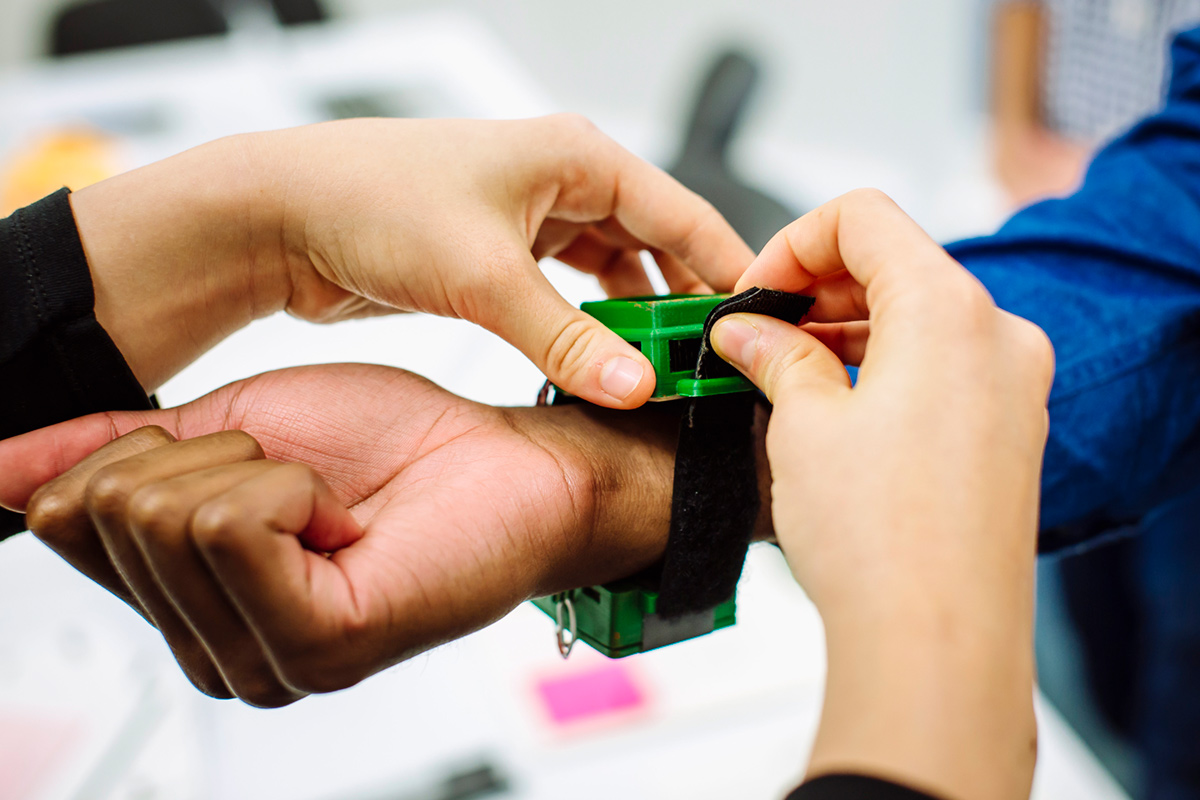The Coolest Thing
A Trio of Student Inventors Finds a New Way to Beat the Heat

Helen Yates
From a construction site in sweltering south Georgia to an elegant English castle, a team of Emory students went on a globe-trotting, million-dollar quest this summer to address one of the world’s most urgent challenges— helping people find physical comfort in the face of climate change.
Their answer, the Vimband, is a personal temperature-regulation device that could be worn to cool the body in extremely hot weather or warm those in severely cold temperatures.
Amid reports that global temperatures are climbing, direct body cooling could go far in providing personal relief for populations living in increasingly hot climates, says Ryan James 21C, a business and computer science major who convened a team of Emory students to explore a solution.
“Worldwide, the use of air-conditioning is expected to nearly triple by 2050, and with detrimental environmental effects, that isn’t a sustainable solution,” James says.
Instead of controlling the temperatures of buildings, the Emory team set their sights on a smaller, more efficient target—the human body. They created a prototype for a rechargeable device that essentially functions as a personalized heating and cooling unit. The compact box may be worn around the wrist, neck, or head—pulse points near major arteries that play a critical role in regulating body temperature.
The device was conceived and developed by James, Jesse Rosen-Gooding 21C, and Kieren Helmn 19C to compete for the Hult Prize, an annual business innovation challenge open to students around the world. The competition’s charge is to create market-driven, socially conscious, sustainable business solutions for big problems, especially those affecting low-income communities.
Although they did not advance to September’s finals at the United Nations in New York City, Emory’s team won at the local and regional levels to earn one of fifty spots in the Hult Castle Accelerator, an intensive six-week summer program at Ashridge House, a sprawling country estate northwest of London. This was the first time Emory students have progressed into the Hult Accelerator round, and it was the chance of a lifetime to put their idea into action. All three students are Woodruff Scholars in Emory College of Arts and Sciences, and they met and began working together through the Emory Scholars Program.
“I had taken a gap year before coming to Emory, which I spent living with a host family in East Timor,” says Rosen-Gooding. “I found it unbearably hot, sweating throughout the night, and thought, ‘This is what we need to target— getting cooling solutions to people where they most need it.’ ”
So they came up with the idea of direct body cooling, a solution that’s easy on the environment while enhancing the health and comfort of individuals. Their research led them to thermoelectric modules.
“Thermoelectric coolers are used in your computer, your refrigerator, even the Mars Rover,” explains Helmn. “We weren’t inventing a new technology, we were just applying it in a way it hadn’t quite been done before.”

To build a prototype, the team used the 3D printer at MAKEmory to create sample cases and components. For a silicone wristband, they employed a CNC (computer numerical control) carving machine. Soldering and electronics equipment allowed for the assembly of internal hardware.
Then they took their prototype to Miami for field research. “We tried it on about 104 people on the beach, and ninety-nine said they would buy one,” Helmn recalls. “That was when we started believing there might actually be a market for this.”
The team won several campus competitions—including Emory’s Entrepreneurship Summit at Goizueta Business School—before landing a spot among sixty teams at a Hult Prize regional competition in San Francisco, where they placed a close second. Encouraged by Hult Prize CEO and founder Ahmad Ashkar, the team applied to the wild card round, and was picked as one of ten additional teams to attend the coveted Hult Castle Accelerator.
The team has also continued to work with Georgia Tech engineers to refine their prototype, and to collaborate with Emory faculty, including Valerie Mac, an assistant professor at the School of Nursing who studies the impact of environment and occupational health on vulnerable populations.
Earlier this summer, the team worked with Mac to help design study protocol and surveys to measure the Vimband’s effectiveness on construction workers laboring in ninety-degree-plus heat near Plains, Georgia. James and Helmn helped enroll participants, whom Mac tracked for a week, measuring skin temperature, heart rate, and activity levels. In addition to collecting biometric data, Mac also interviewed subjects about the Vimband’s perceived comfort and utility.
“It is very motivating for me to work with students who really want to have an impact and are integrating business, technology, research, and public health,” she says.
Though the Hult Prize was a potent incentive, Emory team members say they were driven by a sense of social responsibility, nurtured by the educational environment Emory provides.
“It’s critical that our future generation of entrepreneurs are building businesses which are embedded with social impact,” says Helmn. “We now have the chance to create sustainable businesses that make a real difference in people’s lives all around the world.”


